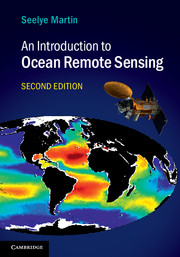Book contents
- Frontmatter
- Contents
- Preface
- List of chemical symbols
- List of mathematical symbols
- List of abbreviations and acronyms
- 1 Background
- 2 Ocean surface phenomena
- 3 Electromagnetic radiation
- 4 Atmospheric properties and radiative transfer
- 5 Reflection, transmission and absorption at the atmosphere/ocean interface
- 6 Ocean color
- 7 Infrared observations of sea surface temperature (SST)
- 8 Introduction to microwave imagers
- 9 Passive microwave observations of the atmosphere and ocean surface
- 10 Introduction to radars
- 11 Scatterometers
- 12 The altimeter
- 13 Imaging radars
- 14 Other instruments: the gravity missions, ICESat-1 and -2, CryoSat-2, SMOS and Aquarius/SAC-D
- Appendix
- References
- Index
- Plate Section
6 - Ocean color
Published online by Cambridge University Press: 05 June 2014
- Frontmatter
- Contents
- Preface
- List of chemical symbols
- List of mathematical symbols
- List of abbreviations and acronyms
- 1 Background
- 2 Ocean surface phenomena
- 3 Electromagnetic radiation
- 4 Atmospheric properties and radiative transfer
- 5 Reflection, transmission and absorption at the atmosphere/ocean interface
- 6 Ocean color
- 7 Infrared observations of sea surface temperature (SST)
- 8 Introduction to microwave imagers
- 9 Passive microwave observations of the atmosphere and ocean surface
- 10 Introduction to radars
- 11 Scatterometers
- 12 The altimeter
- 13 Imaging radars
- 14 Other instruments: the gravity missions, ICESat-1 and -2, CryoSat-2, SMOS and Aquarius/SAC-D
- Appendix
- References
- Index
- Plate Section
Summary
Introduction
This chapter reviews the retrieval of organic and inorganic, dissolved and suspended material in the water column. While the last chapter discussed the properties of clear water and defined the irradiance reflectance, water-leaving radiance and the radiance received at the satellite, this chapter shows how the presence of dissolved and suspended material alters the wavelength-dependence of the water-leaving radiances from their clear-water values. As the following shows, satellite observations in the visible and near infrared allow retrieval of the oceanic chlorophyll a (Chl-a), the principal photosynthetic pigment associated with oceanic plant life.
Most oceanic plants are microscopic single- or multi-celled free-floating plants called algae or phytoplankton, from the Greek phyton, meaning plant, and planktos, meaning wandering (Jeffrey and Mantoura, 1997). Phytoplankton use photosynthesis to fix inorganic carbon into organic forms of carbon such as carbohydrates. They reproduce asexually, are globally distributed, consist of tens of thousands of species and make up about 25% of the total planetary vegetation (Jeffrey and Mantoura, 1997). Jeffrey and Vesk (1997) and Lalli and Parsons (1993) provide an introduction to the kinds and variety of phytoplankton species.
- Type
- Chapter
- Information
- An Introduction to Ocean Remote Sensing , pp. 136 - 193Publisher: Cambridge University PressPrint publication year: 2014
- 1
- Cited by

